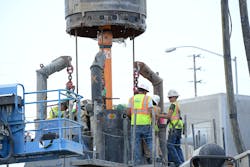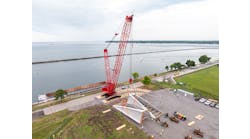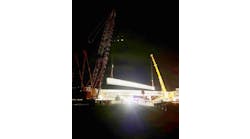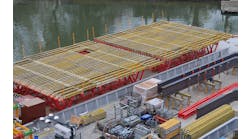By: Arthur Schurr
Some people believe that a replacement can never substitute properly for an original. History teaches us otherwise.
For when it comes to the replacement for the Gerald Desmond Bridge, nothing could be further from the truth. Though the new bridge will be a replacement, technically, it provides original solutions for the port of Long Beach, the city of Long Beach and even international trade.
Getting clearance
Since its creation, the Gerald Desmond Bridge (GDB) has executed its mission well. Constructed in 1965 and opened to traffic in 1968, the nearly mile-long, through-arch bridge over the Cerritos Channel connects Ocean Boulevard/I-710 to Terminal Island in the port of Long Beach (POLB). Replacing a World War II-era pontoon bridge, the GDB features a 410-ft-long suspended main span with a 155-ft vertical clearance over the channel. For its time, the GDB served admirably, a critical conduit connecting the port to the mainland and to I-710. But in today’s world of ever-increasing traffic and post-Panamax shipping, what was once a vital link has become somewhat of a liability.
“This project has been 10-15 years in the making,” explained POLB Community Relations Manager John Pope. “And there are several compelling reasons for the replacement. But the most pressing reason was functionality. The current bridge has one of the lowest clearances of any seaport bridge in the U.S. So it can’t accommodate post-Panamax ships; they just don’t fit under the bridge. And the bridge is strategically located within the port. So clearance is very important. But the issues are not just waterborne.
“The current bridge also does not accommodate today’s traffic volume. But this isn’t just about local traffic commuting to work. The bridge carries 15% of the nation’s cargo across it. That adds up to about 65,000-70,000 total vehicles per day, about 18 million trips per year. And cargo from the port and commuter traffic are only growing. So replacing the bridge has both local and global implications.”
Other factors drove the replacement decision as well. According to a fact sheet published by the POLB, “While the bridge is safe for commuters today, it is rapidly deteriorating.” The fact sheet explains that on recent inspection Caltrans gave the GDB a low “sufficiency rating” because of its concrete decks and superstructure. In addition, POLB installed protective netting under sections of the bridge to prevent “falling pieces of concrete from hitting workers, the ground, or waterways below.” Finally, maintenance costs on the aging bridge continue to increase and “cannot be sustained long-term.”
Pope believed the replacement bridge addresses all of these issues and then some. But he also knows the reality of replacing this particular bridge in this particular setting.
“The new bridge will allow post-Panamax shipping to safely and easily pass underneath. But it also will be a vast improvement for traffic as well. The new bridge will have three lanes in each direction, with dedicated emergency lanes. That’s a key factor when you have a lot of cargo trucks. Another key feature are the bike and pedestrian paths. And the current bridge’s steep grades will be reduced in the new bridge. But replacing the bridge is anything but easy. We have to manage construction while minimizing the impact on our cargo operations. We can’t just shut down the port to build the bridge. The port is part of the busiest port complex in the U.S. So there will be quite a bit of coordination to ensure the port stays fully operational.”
Ground forces
A joint effort of the California Department of Transportation (Caltrans) and the POLB, the U.S. DOT and the Los Angeles County Metropolitan Transportation Authority also contributed funds for the $1.2 billion design-build project. When completed, the unnamed-as-yet, cable-stayed replacement bridge will rise above the water to provide 205 ft of vertical clearance. Featuring two 515-ft twin towers, the new bridge will be the first cable-stayed vehicular bridge on the West Coast and the second-tallest cable-stayed bridge in the U.S. today. It will grow to approximately 8,800 ft in length, including a 2,000-ft main span. More than 70 columns will support the east and west approach spans supported by more than 300 below-ground piles. Slated to be the tallest structure in the Long Beach skyline, it was, however, the ground that posed one of the greatest challenges. Pope explained.
“There were active oil wells that had to be relocated and inactive wells that had to be capped. There were also quite a few inactive casings that had to be moved, and that’s where the real difficulty came in. This work really isn’t done in the petroleum or construction industry, where capped, inactive wells are dug out. In some cases, we had to go as deep as 200 ft.”
According to Pope, the project team had to remove several of the longer oil-well casings in sections. Engineers had to design and fabricate custom tools to cut the steel pipes from both inside and out. This was done in a protective 7-ft-diam. drum that stabilized surrounding soil during the procedure. Once the entire casing was removed, the project team filled the cavity with a mixture of sand and mud. But removing these casings was not the only challenge.
Many of the oil wells and utilities in the project area were never documented accurately. Originally dug before GPS existed, many wells were recorded, but not exactly located as documented. In some cases, the project team had to dig around to find some of the wells. Pope said it was not quite “needle-in-the-haystack” searching, but also it was not as simple as projects where the documentation is true. But the project team faced another serious concern: considerable subsidence issues.
Much of Terminal Island is landfill. The result of an oil boom in the 1950s, parts of Terminal Island sank as much as 30 ft. Subsequently, soil was used to cover the submerged ground. Adding insult to later injury, new utility lines were placed in the area and then they were covered with even more soil. For the project team, the landfill/utility/pipeline/landfill sandwich presented a distinctive dilemma.
“Some of the greatest challenges occurred where the port sank as much as 30 ft,” added Pope. “When they capped oil wells there, they might have capped them only 2 to 5 ft below the surface at the time. But over time, the surface level changed; it kept rising. So that 2 to 5 ft then became 35 or 40 ft below the surface, when the surface level was raised over time. Though it’s stabilized now, it still continues to sink a little bit. But that isn’t the only challenge our team encountered.
“There were also close to a dozen structures in the bridge’s path. So those buildings had to be demolished. And there were two major freeway connectors that had to be demolished as well. In addition, there were belowground sewer, outflow and water pipes and utilities that had to be relocated or removed. Some were abandoned long ago with no record of whose they were. Remember, the port is 100 years old, so documentation on some of these things can get lost over time, especially the earlier elements. There were also technical engineering challenges with the soil itself.
“The soils here have many different layers of strata. It’s a complex soil system and they’re not in neat rows. Because the port was an industrial property for its entire existence and Terminal Island was previously a naval base, there are some legacy contamination issues. All soils extracted from digging the foundation have to be treated. Also, two aquifers have to be crossed when drilling the foundations, and the lower aquifer is contaminated with benzene. Because of that we must prevent cross contamination and seepage when drilling. But that means that each cluster of piles is virtually its own engineering project. So there are 330 foundations grouped into clusters of four to five foundations. Those clusters will be connected with a pile cap, and a column on top of that with about 70 columns in total. If you do the math you can see the challenge we’re facing.”
Today, the work continues apace. While some demolition remains, Pope says the project team is focusing on foundation work, with nearly 10 foundations in place so far. And the project team is constructing the new bridge alongside the old bridge. Crews are building foundations and will soon begin fabricating the superstructure with the use of two moveable scaffolding systems.
During the next several years of construction, the project will generate approximately 3,000 construction and support jobs each year. Though acutely aware of the challenges and the costs, when it comes to the bridge itself, Pope is somewhat philosophical.
“Without question, this project has been challenging. And in some cases, it’s taken longer than we expected. But this is something that we’ve never done before. And we want it done right. We expect this to be a 100-year structure.”
Some people believe that a replacement can never substitute for an original. When it comes to the replacement for the Gerald Desmond Bridge, nothing could be further from the truth. With the new Gerald Desmond Bridge replacement, the POLB and the project team are making quite an original statement for the city of Long Beach and beyond. R&B
About The Author: Schurr is a New York-based freelance writer who reports on transportation infrastructure.



